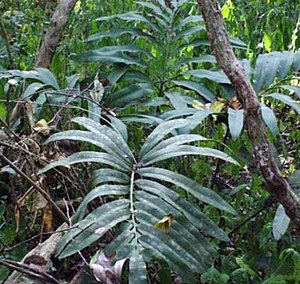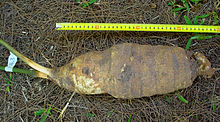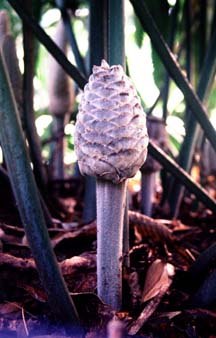Stangeria eriopus
| Stangeria eriopus | ||||||||||||
|---|---|---|---|---|---|---|---|---|---|---|---|---|

Stangeria eriopus |
||||||||||||
| Systematics | ||||||||||||
|
||||||||||||
| Scientific name of the genus | ||||||||||||
| Stangeria | ||||||||||||
| T. Moore | ||||||||||||
| Scientific name of the species | ||||||||||||
| Stangeria eriopus | ||||||||||||
| ( Kunze ) Baill. |
Stangeria eriopus ( xho : Umfingwani ) is a species of palm ferns (Cycadales); it is the only species of the monotypic genus Stangeria . The species is endemic to a narrow strip on the east coast of South Africa and southern Mozambique .
description
Stangeria eriopus is a very long-lived, perennial , evergreen cycad. The species has 2n = 16 chromosomes . The karyogram shows twelve metacentric , two submetacentric and two acrocentric chromosomes.
Shoot axis and root
The stem axis and main root form an underground, carrot-shaped trunk, often also referred to as a tuber, which reaches a diameter of 10 to 25 centimeters. The tip branches forked into several shoot tips. These form woolly scales at the beginning, but they fall off early.
As with other cycads, coral-like roots are sometimes formed in which nitrogen-fixing bacteria , Bacillus radicola and Azotobacter sp. , Life.
leaves
The stalked, pinnate leaves look very similar to fern fronds and are between 25 centimeters and two meters long. The petiole alone makes up half the length. The young leaves are bent in the bud position , the tip appears rolled up. Young leaves are covered with short, gray hairs, which usually fall off quickly and only stick to the base of the petiole. These trichomes are unbranched and transparent or colored. Only one leaf is formed at a time on each tip of the shoot.
The individual leaves are leathery and very variable in texture and size. They are in five to 20 opposing pairs. The lower ones are short-stalked, while the upper ones are fused together at the base. The vein is unique for a cycad. In the other cycads the leaf veins are simply forked ( dichotomous ), whereas in Stangeria eriopus the middle nerve is thickened and the weak side nerves branch out from it. These in turn branch briefly at the median nerve at least one, up to four, more times.
Cones, pollination, fertilization and seeds
Like all cycads, Stangeria eriopus is dioeciously separated, so there are male and female individuals ( diocyte ). Both the male and female cones are petiolate. One cone is always formed per meristem. The plants are sexually mature for the first time after five to seven years.
The male cone is cylindrical and tapers towards the tip. It reaches a diameter between 30 and 40 millimeters and is between ten and 25 centimeters long. In youth, it is covered with silvery hairs that fall off to maturity. The cone then turns yellowish brown.
The scales (= microsporophylls ) are arranged cylindrically around the pin axis. Their shape is triangular to rhomboid. Each microsporophyll forms around 150 pollen sacs , which are attached to the underside in groups of three to six. When ripe, the cone axis elongates and the scales are lifted apart and release the pollen. Two to eight strong vascular bundles run along the peg axis , as well as a double strand of diverging lateral vascular bundles that originate on the central axis. In contrast to all other cycads, with the exception of Cycas rumphii , secretory idioblasts are found in the parenchyma of the sporophylls and not exclusively in the epidermis or in the hypodermis .
The pollen has a glycocalyx on the outside , which consists of tightly packed cylindrical units measuring 20 to 150 nanometers in diameter. They are perpendicular to the plasma membrane . Below is the sporopollenin . The germ openings (apertures) are more proximal than distal. At the distal end of each pollen grain there is an unusual depression (pseudosulcus) that resembles a “failed” distal aperture.
The female cones are ellipsoidal to conical with a rounded tip. As with the male cones, when they are young they are covered with silvery hairs that fall off when they reach maturity. As they ripen, they turn dark green. The cones are about 18 centimeters long and about 8 centimeters in diameter. Like the male microsporophylls, the female megasporophylls are arranged cylindrically around the cone axis. But their tips form six vertical lines.
The ovules arise at the base of the megasporophyll and reach a size of 35 × 25 millimeters. When the cone is ripe, the megasporophylls separate from each other. The micropyle secretes a drop of liquid that draws the pollen to the embryo sac by capillary action as it dries out. After the seeds ripen, the female cones dissolve and the seeds fall to the ground. They consist of a hard, dark red part that is surrounded by a fleshy, purple seed coat that later turns brown. They are about 2 inches long and about 14 millimeters wide.
Chromosome number
The number of chromosomes is 2n = 16.
ingredients
The tuber is rich in carbohydrates and contains an exceptionally high concentration of sodium sulfate , which explains the nauseating effect. The most common biflavones in the leaves are amentoflavone and bilobetin.
distribution
Stangeria eriopus is endemic to a narrow, approximately 800 km long strip on the east coast of South Africa and southern Mozambique . The western limit of the distribution area is around Banjul in the Sarah Baartman district . The area extends to about 50 kilometers inland and approaches the ocean up to two kilometers.
The species has a low salt tolerance - but is sometimes found in meadows near the coastal dunes, where the plants are protected from salt water. It grows in full sun meadows as well as in shady coastal forests. Sandy, slightly acidic soil is preferred, on the northern border of the distribution area Stangeria eriopus also grows on clay and very stony soils.
Danger
The International Union for Conservation of Nature and Natural Resources (IUCN) classifies Stangeria eriopus on its red list as: " Near Threatened ". The species is particularly threatened by the destruction of its habitat and by digging up the plants.
Another possible threat of the species is the lid scale louse (Diaspididae) Aulacaspis yasumatsui . The insect originally comes from Thailand and attacks cycads there. The pest has now been introduced to Florida, Hawaii, Hong Kong and the Cayman Islands, where it causes great damage to cycads. Would the kind coming to South Africa, they could in a short time Stangeria - population reduced drastically or even destroy.
Stangeria eriopus is also attacked by the fungus Guignardia mangiferae , which causes great damage to citrus fruits, but remains without symptoms. The larvae of the butterfly Callioratis millari feed on the leaves of the species.
It is possible to generate clones of Stangeria eriopus from root parts. It is the first cycad that could be propagated via tissue culture . This greatly simplifies the conservation of the species.
history
When Gustav Kunze discovered the first plants, he wrongly defined them as ferns and named them Lomaria coriacea . In 1839 he described it as a separate species, albeit as the fern Lomaria eriopus . He was probably fooled by the primitive nerves. It wasn't until 1851 that William Stanger discovered they were cycads when he found the cones. He sent samples to England, where Thomas Moore described the species as Stangeria paradoxa in 1853 , thus establishing the genus. However, since the epithet eriopus was validly described by Kunze, Henri Ernest Baillon established the correct name Stangeria eriopus with his description in 1892 .
etymology
The generic name was chosen in honor of William Stanger (1811-1854), who sent the first cones to England. He was an English doctor and naturalist who worked in South Africa. The town of Stanger in KwaZulu-Natal, which is now called KwaDukuza , was named after him . The type epithet is made up of the ancient Greek nouns έριον ( érion , "wool" ) and πούς ( pous , "foot" ). It reflects the woolly base of the petioles.
Systematics
The closest relative to Stangeria eriopus is the genus Bowenia , with which it forms the family of the Stangeriaceae. This is shown by morphological investigations and analyzes of the biflavone content in the leaves. The genus Eostangeria , which died out in the Tertiary period, was about equally closely related . The species Eostangeria pseudopteris has been described from fossil remains from this genus .
Molecular genetic studies show, however, that the Stangeria are more closely related to the genus Ceratozamia than to the Bowenia or Microcycas , from which the paraphyly of the Stangeriaceae family would follow.
use
In traditional medicine, the thickened underground tuber trunk is mainly used. It is used both to make various magical tinctures and as an emetic . In veterinary medicine, the dried tuber is mixed with cattle feed to combat internal parasites.
For these purposes, the plants are collected and sold; this goes so far that the population is now endangered. In 2005, 5 cents were paid for one gram of the tuber on the market in Mthala .
literature
- Cynthia Giddy: Cycads of South Africa . 2nd Edition. Purnell , Cape Town, New-York 1974, ISBN 978-0-360-00274-6 .
- Dennis Wm Stevenson: Cycads of the World: Ancient Plants in Today's Landscape . 2nd Edition. Smithsonian Books , 2002, ISBN 978-1-58834-043-6 .
- Knut J. Norstog, Trevor J. Nicholls: The Biology of the Cycads . Comstock Publishing Associates , Ithaca 1997, ISBN 978-0-8014-3033-6 , pp. 265 f .
- Piet Vorster, Elsa Vorster: Focus on Stangeria eriopus . In: Encephalartos . tape 2 , 1985, pp. 1-11 .
- Robert Buckley: A New Significance for Stangeria . In: The Cycad Newsletter . tape 24 , no. 4 , 2001, p. 1–5 ( full text ).
Individual evidence
- ↑ a b Goro Kokubugata, Ken D. Hill, Katsuhiko Kondo: Ribosomal DNA distribution in somatic chromosomes of Stangeria eriopus (Stangeriaceae, Cycadales) and molecular-cytotaxonomic relationships to some other cycad genera . In: Brittonia . tape 54 , no. 1 , January 2002, p. 1-5 , doi : 10.1663 / 0007-196X (2002) 054 [0001: RDDISC] 2.0.CO; 2 ( abstract ).
- ↑ Dennis Wm. Stevenson: Observations on Ptyxis, Phenology, and Trichomes in the Cycadales and their Systematic Implications . In: American Journal of Botany . tape 68 , no. 8 , 1981, p. 1104-1114 , doi : 10.2307 / 2442720 .
- ↑ Dennis Wm. Stevenson, Knut J. Norstog, Dian V. Molsen: Midribs of Cycad Pinnae . In: Brittonia . tape 48 , no. 1 , 1996, p. 67-74 , doi : 10.2307 / 2807665 .
- ^ Andrew P. Vovides: Cone Idioblasts of Eleven Cycad Genera: Morphology, Distribution, and Significance . In: Botanical Gazette . tape 152 , no. 1 , March 1991, p. 91-99 ( abstract ).
- ↑ Nina I. Gabarayeva, Valentina V. Grigorjeva: Exine development in Stangeria eriopus (Stangeriaceae): infrastructure and substructure, sporopollenin accumulation, the equivocal character of the aperture, and stereology of microspore organelles . In: Review of Palaeobotany and Palynology . tape 122 , no. 3–4 , pp. 185-218 , doi : 10.1016 / S0034-6667 (02) 00183-5 .
- ^ Tropicos. [1]
- ↑ R. Osborne, A. Grove, P. Oh, TJ Mabry, JC Ng, AA Seawright: The magical and medicinal usage of Stangeria eriopus in South Africa . In: Journal of Ethnopharmacology . tape 43 , no. 2 , 1994, p. 67-72 , doi : 10.1016 / 0378-8741 (94) 90005-1 .
- ↑ a b Barbara Meurer-Grimes, Dennis W. Stevenson: The Biflavones of the Cycadales Revisited: Biflavones in Stangeria eriopus, Chigua restrepoi and 32 Other Species of Cycadales . In: Biochemical Systematics and Ecology . tape 22 , no. 6 , 1994, pp. 595-603 , doi : 10.1016 / 0305-1978 (94) 90072-8 .
- ^ TJ Weissling, FW Howard, AB Hamon: Cycad Aulacaspis Scale, Aulacaspis yasumatsui Takagi (Insecta: Homoptera: Sternorrhyncha: Diaspididae) . In: Florida Coop. Ext. Service Publication document EENY-096 . July 1999 ( pdf ).
- ↑ RP Baayen, PJM Bonants, G. Verkley, GC Carroll, HA van der Aa, M. de Weerdt, IR van Brouwershaven, GC Schutte, W. Maccheroni Jr., C. Glienke de Blanco, JL Azevedo: Nonpathogenic Isolates of the Citrus Black Spot Fungus, Guignardia citricarpa, Identified as a Cosmopolitan Endophyte of Woody Plants, G. mangiferae (Phyllosticta capitalensis) . In: Ecology and Population Biology . tape 92 , no. 5 , 2002, p. 464-477 ( pdf ).
- ^ Robert Buckley: Inducing Adventitious Rooting in Cycad Leaves . In: The Cycad Newsletter . No. 1 , 1999 ( pdf ).
- ↑ a b Lotte Burkhardt: Directory of eponymic plant names . Extended Edition. Botanic Garden and Botanical Museum Berlin, Free University Berlin Berlin 2018. [2]
- ↑ Hooker's Journal of Botany and Kew Garden Miscellany. London, Volume 5, 1853, p. 228 ( online )
- ↑ Histoire des Plantes Monograph des Conifères, Gnétacées, Cycadacées, Alismacées, Triuridacées, Typhacées, Najadacées et Centrolépidacées. Paris, 1892, p. 68 ( PDF )
- ↑ Helmut Genaust: Etymological dictionary of botanical plant names. 3rd, completely revised and expanded edition. Nikol, Hamburg 2005, ISBN 3-937872-16-7 , pp. 234, 608 (reprint from 1996).
- ^ AP Dold, ML Cocks: Traditional veterinary medicine in the Alice district of the Eastern Cape Province, South Africa . In: South African Journal of Science . tape 97 , no. 9 & 10 , 2001, ISSN 0038-2353 , p. 375–379 ( full text ( memento of March 13, 2008 in the Internet Archive ) (PDF)). Traditional veterinary medicine in the Alice district of the Eastern Cape Province, South Africa ( Memento of the original from March 13, 2008 in the Internet Archive ) Info: The archive link was automatically inserted and has not yet been checked. Please check the original and archive link according to the instructions and then remove this notice.
- ↑ J. Keirungi, C. Fabricius: Selecting medicinal plants for cultivation at Nqabara on the Eastern Cape Wild Coast, South Africa . In: South African Journal of Science . tape 101 , no. 11 & 12 , 2005, ISSN 0038-2353 , p. 497-501 .
Web links
- Stangeria eriopus in the endangered Red List species the IUCN 2007. Posted by: Donaldson, 2003. Retrieved on 22 September, 2007.
- Description on the pages of the Cycad Society of South Africa (in English)
- Description on conifers.org (in English)




